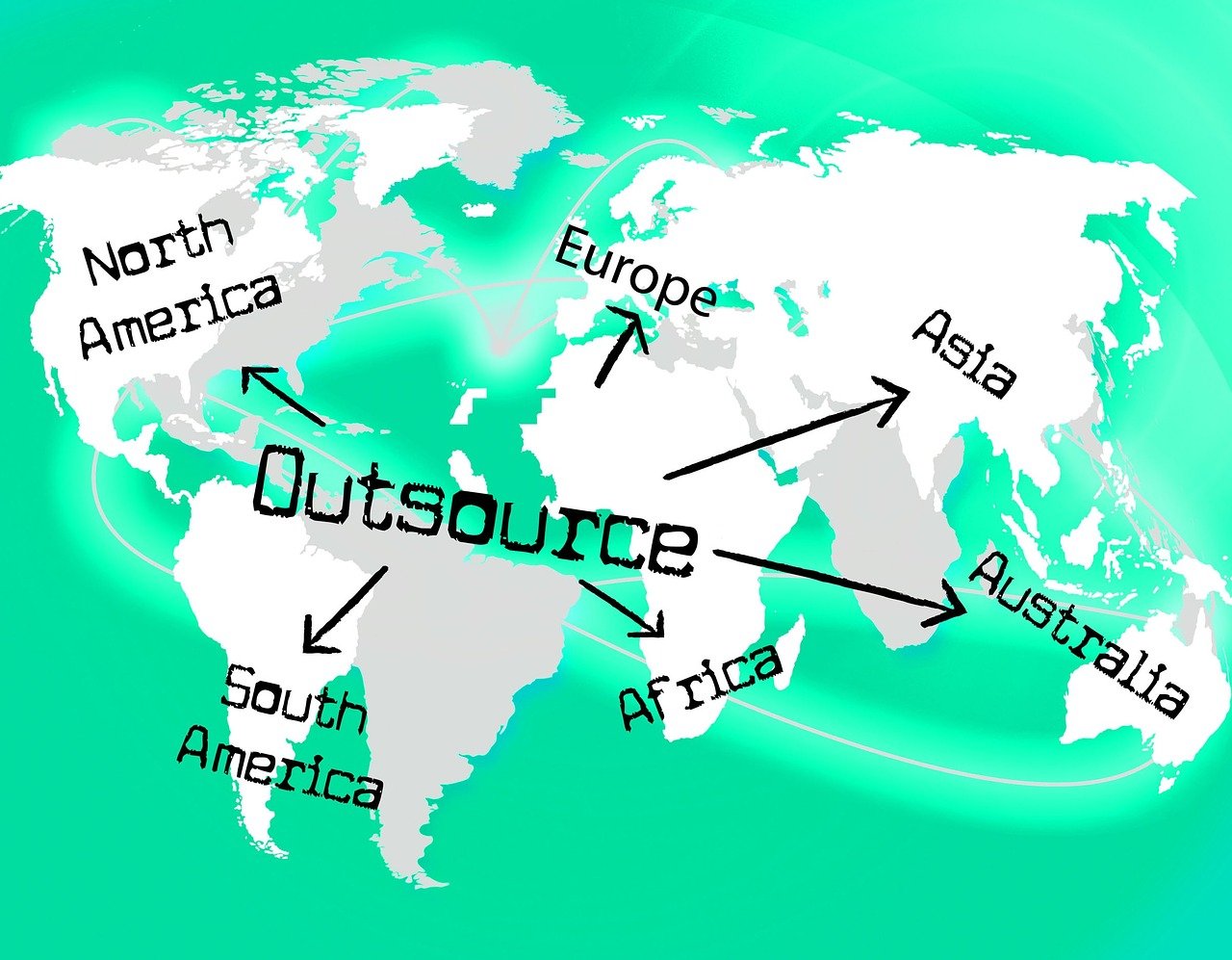Imagine your business unlocking untapped potential, slashing costs, and skyrocketing efficiency in 2025—simply by embracing the right outsourcing trends.
The global outsourcing market is projected to rake in a staggering $410 billion this year. With competition intensifying, the need to stay ahead has never been greater. Embrace change now, or risk falling behind.
In this article, we’ll dive into the eight game-changing outsourcing trends that will reshape how businesses operate in 2025. Get ready to learn what’s on the horizon, so you can position your business for success and outpace the competition.
Trend 1: How AI and Human Collaboration Will Transform Your Business

Human expertise, working hand in hand with the latest in Artificial Intelligence is reshaping what’s possible in business.
Imagine a call center where chatbots handle thousands of customer queries every hour, responding instantly, accurately, and without a hint of fatigue. This is the reality of AI automation and it is significantly changing the game.
With AI, large corporations can scale and serve large numbers of customers without significant investments in manpower and training.
Tools like chatbots have taken over first-level customer support, handling everything from answering simple FAQs to troubleshooting. Robotic process automation (RPA) is dealing with repetitive workflows like data entry, and completing in seconds processes that used to take hours.
Meanwhile, human tech experts are busy with complex problem-solving, system optimization, and driving strategic innovation.
The result? Remote work outsourcing providers are becoming faster, smarter, and better equipped to deliver value to client businesses.
The virtues of AI automation include:
- Cost Reduction: With AI, companies save on labor costs while maintaining quality output.
- Faster Turnaround Times: Tasks are performed quickly and consistently, meeting tight deadlines with ease.
- Scalability: Whether it’s scaling up during peak seasons or handling unexpected surges, AI-driven processes offer the flexibility businesses need.
As a field, AI is itself rapidly evolving, with even more powerful capabilities going online. According to McKinsey, generative AI will significantly impact the different elements of business. McKinsey estimated that generative AI’s potential productivity lift in the marketing and sales functions is around $463 billion and $486 billion respectively.

Because of these benefits, the use of AI in outsourcing will continue to be a trend in 2025
How To Adapt:
- Evaluate repetitive tasks in your business processes that can be automated using AI. Consider investing in chatbot solutions and other AI-powered tools.
- Enhance Decision-Making: Utilize AI-powered data analytics tools to provide insights, allowing employees to make more informed and faster decisions.
- Upskill Human Workforce: Focus on developing human skills in AI management, strategic oversight, and advanced problem-solving to maximize the potential of AI collaboration.
Case In Point: Amazon’s Smart Use of AI
Amazon has mastered the art of using AI to enhance its outsourced operations. Their AI-powered chatbots tackle millions of routine customer queries—think order tracking, returns, and FAQs—letting human agents focus on more complex issues.
The payoff? Shorter wait times, happier customers, and cost savings allow Amazon to reinvest in growth.
For businesses, the lesson is clear: integrating AI into outsourcing is a serious competitive advantage. By embracing automation, companies can elevate their operations, reduce costs, and stay ahead in an increasingly lightning-paced market.
Trend 2: Expansion of Remote Work To New Geographies

With the steady growth of remote work, businesses have long been freed from the constraints of geography. Outsourcing has allowed companies to tap into skilled professionals from virtually anywhere around the world—creating opportunities to access top talent while optimizing costs.
From software developers in Eastern Europe to marketing experts in the Philippines, the global talent pool has never been more accessible. Companies are leveraging this shift to fill specialized roles faster while reducing labor costs.
For example, the Philippines is a leading hub for outsourcing, particularly in the tech sector, as well as accounting, virtual assistance, and customer service.
Poland and Kenya are emerging geographies following the footsteps of powerhouses Philippines and India. Every year new geographies are being unlocked, bringing fresh perspectives to the remote working approach.
While many regions are still in the nascent stage, their coming to the marketplace is good news. More players mean more competitive pricing for businesses.
Outsourcing levels the playing field. For startups, it allows small businesses to compete with industry leaders without overextending their budgets.
Remote work offers a number of benefits, including :
Cost savings without compromising on quality: Outsourcing roles to countries with lower labor costs allows businesses to stretch their budgets without sacrificing output.
Diverse creativity and skill Sets: Different regions bring distinct strengths.
24/7 operations: Working across multiple time zones means projects move forward around the clock, increasing efficiency and speed.
How To Adapt:
- Offer Flexible Working Arrangements: Provide remote work opportunities for outsourced talent to attract a broader pool of candidates. Create a remote work policy that aligns with both internal and outsourced teams.
- Partner with outsourcing agencies in trusted markets like the Philippines to access cost-effective, skilled talent.
- Measure Outsourced Talent Performance: Develop KPIs to assess the performance of outsourced talent and make sure their work meets expectations. Provide feedback regularly and adjust the outsourcing arrangement if necessary.
Case In Point: A US startup’s remote success
To scale its operations, a US-based startup specializing in e-commerce outsourced its accounting and marketing functions to expert professionals in the Philippines.
The results were transformative. The Filipino accounting team streamlined their bookkeeping and tax prep, ensuring compliance and significant savings. Meanwhile, their remote marketing team managed social media campaigns and email outreach, driving engagement and boosting sales—all while remaining seamlessly aligned with the startup’s goals.
Outsourcing has allowed the startup to allocate its resources toward more product innovations and better customer experience, fueling rapid growth without stretching its local teams too thin.
By embracing remote work and outsourcing globally, businesses achieve a competitive edge in highly contested spaces.
Trend 3: Intense Focus on Cybersecurity

As remote work outsourcing grows, so does the importance of cybersecurity. Outsourcing often involves sharing confidential information such as customer data, intellectual property, and financial records.
As a result, safeguarding sensitive data has become a primary concern. With cyber threats on the rise, companies are prioritizing robust security measures when engaging outsourcing partners.
The transfer of sensitive information comes with inherent risks. Large companies, especially those that are housing significant volumes of data are guarding against things like:
Data Breaches: Unauthorized access to sensitive information can result in financial losses and reputational damage.
Compliance Failures: Companies are required to adhere to data protection laws like GDPR, HIPAA, and CCPA, making it essential for outsourcing partners to meet these standards.
Businesses are now demanding ever greater transparency and accountability from their partners—with security certifications, encryption systems, and compliance audits as baseline requirements.
Small businesses and organizations must prioritize data protection, as they have also become prime targets due to weak security measures.
So businesses are doubling down and also outsourcing cybersecurity functions instead of doing it in-house. There is a huge cybersecurity skills gap within companies, with 71% of organizations admitting to a shortage of cybersecurity talent.
According to Kaspersky, 4 in 10 companies plan to outsource their cybersecurity. This is in a bid to head off burnout rates and staff attrition.
Looking at the EU27 average, for the 27 member-states comprising the European Union, we find that half of their companies outsource cybersecurity functions.

Specialized firms offer 24/7 monitoring, incident response, and vulnerability assessments—offering expertise, experience, and cutting-edge tools to bear—bringing peace of mind to partner businesses.
How To Adapt:
- Work with specialized cybersecurity firms to handle real-time monitoring, risk assessments, and compliance management.
- Demand Security Standards: Choose outsourcing partners with high-level security certifications and demonstrate compliance with laws like GDPR and HIPAA.
- Integrate Proactive Measures: Regularly evaluate and update cybersecurity protocols to stay ahead of threats and ensure customer data protection.
Case In Point: A Financial Firm Safeguards Its Data
Consider a mid-sized financial services firm in the United States concerned with the growing complexity of cyber threats. Rather than attempt to manage security in-house, the firm partnered with an offshore cybersecurity provider with expertise in financial data protection.
The provider implemented:
Real-Time Monitoring: A dedicated team tracked system activity around the clock, identifying and addressing anomalies before they could escalate.
Proactive Risk Assessments: Regular vulnerability scans highlighted potential weaknesses in the firm’s IT infrastructure.
Compliance Management: The outsourcing partner ensured the firm met stringent industry standards, avoiding costly penalties and preserving customer trust.
To date, the financial firm experienced no breaches, reduced its operational costs, and bolstered client confidence by showcasing its commitment to data security.
Cybersecurity providers are invaluable allies in the digital age. By partnering with trusted experts, businesses can mitigate risks, meet compliance standards, and focus on growth.
Trend 4: Outsourcing for Highly Specialized/Niche Roles
Outsourcing used to be primarily associated with basic, repetitive tasks. However, the landscape has evolved over time.
Today, companies are outsourcing for more specialized roles—those tasks that require expert-level skills in areas such as software development, cutting-edge digital marketing, and creative design.
For startups, outsourcing has become an affordable means of tapping expertise for a limited engagement.
Rather than burdening internal teams or hiring expensive full-time staff, companies are turning to outsourced experts who can provide precise skills at a specific phase of a project.
For example, software development teams often require specialized developers with proficiency in emerging programming languages or advanced technologies.
How To Adapt:
- Use Outsourcing for Project-based Work: Hire outsourced specialists only for specific phases of a project, minimizing overhead costs and maximizing efficiency.
- Outsource compliance complexities to experts, legal consultants, or regulatory specialists for industries like pharmaceuticals, finance, and energy, ensuring adherence to complex and evolving regulations.
- Reduce Risks in Specialized Functions: Outsourcing high-risk tasks, such as financial auditing, legal counsel, or IT security, can help mitigate the risk associated with these functions by bringing in experts with a track record of success.
Case in Point: Paraplanning in Financial Services
Paraplanning involves supporting financial advisors by preparing reports, creating financial plans, and handling other detailed tasks that require expertise in the financial industry—a role that demands both industry-specific knowledge and strong analytical skills.
A UK-based financial advisory firm was looking to cut costs while maintaining the high standards of service their clients expected. Instead of hiring additional in-house paraplanners, they decided to outsource the role to professionals in the Philippines—a country known for skilled financial professionals.
The outsourcing partner provided highly trained paraplanners with a deep understanding of UK financial regulations, tax laws, and the intricacies of financial planning. This allowed the firm to:
Reduce overhead costs, as the outsourced team offered competitive pricing compared to local hires.
Maintain quality, thanks to the experienced professionals who brought specialized knowledge to the table.
Scale quickly, with the flexibility to bring in more paraplanners as needed without the long hiring processes.
The firm not only achieved significant savings but also improved its efficiency and service quality. Clients received quicker, more detailed financial reports, while the firm’s advisors could focus on building relationships and providing strategic advice.
By leveraging niche expertise from specialized outsourcing providers, companies can access top-tier talent and compete in tough industries.
Trend 5: Outsourcing Tailored for Small Businesses and Startups

Outsourcing is no longer reserved for large corporations and their extensive budgets and complex operations.
Today, micro-businesses, even one-man operations, and startups are increasingly turning to outsourcing as a strategy to level the playing field against larger competitors.
By outsourcing non-core functions, SMEs can focus on their strengths—whether that’s innovation, customer service, or unique product offerings—while leaving time-consuming tasks to trusted external partners.
SMEs tap into specialized skills that would otherwise be unaffordable or unavailable in-house, all while staying lean and flexible.
Popular Outsourcing Services for SMEs include:
Virtual Assistants: Virtual assistants free up valuable time for business owners and employees, allowing them to focus on higher-value activities that drive growth.
Digital Marketing: By outsourcing digital marketing to agencies or freelance specialists, SMEs gain access to digital marketing professionals at a fraction of the cost of an in-house team.
Customer Support: Outsourced customer support services, whether through live chat, phone, or email, helps small businesses scale quickly while maintaining high-quality service.
How To Adapt:
- Outsource Non-Core Functions: Small businesses can outsource administrative tasks, customer service, or marketing to experts, allowing them to focus on growth.
- Use Offshore Virtual Assistants: Free up business owners’ time by outsourcing routine tasks like customer inquiries and order processing.
- Test outsourcing partnerships with short-term or project-based contracts to assess the effectiveness before committing long-term.
Case In Point: A Small E-Commerce Brand Scales with Offshore Virtual Assistants
A small e-commerce startup specializing in handmade jewelry was struggling to keep up with growing orders, customer inquiries, and administrative tasks. As a result, the owner decided to outsource some of the non-core functions to offshore virtual assistants in the Philippines.
The offshore team helped with:
Customer Support: Handling customer inquiries via email and social media.
Order Processing: Managing inventory, processing orders, and coordinating shipments, which sped up the fulfillment process.
Marketing Tasks: Assisting with content creation, and boosting the brand’s online presence and engagement.
The move proved to be a game-changer. The company saw an increase in customer satisfaction and operational efficiency, with the owner being able to focus on expanding the product line.
Trend 6: Nearshoring as a Cost-Effective Alternative

“Nearshoring”—the practice of outsourcing tasks to nearby countries—has gained significant traction and will continue to do so in 2025.
This often involves large companies producing a great number of physical goods.
Unlike traditional outsourcing, which often involves sending jobs to distant countries (eg. China), nearshoring offers companies the benefit of geographical proximity.
For example, U.S. companies are increasingly turning to countries like Mexico or Canada as these locations provide advantages easier travel for in-person meetings, and faster shipment of cargoes.
In 2023, Mexico eclipsed China as America’s top trading partner. That year, Mexico posted growth in sectors with physical manufactured products and goods:

Although its cost savings may be limited, nearshoring affords parties similar time zones. This leads to improved real-time collaboration, smoother workflows, and faster decision-making—critical in fast-paced sectors
How To Adapt:
- Evaluate cultural compatibility: Choose a location with similar work culture and values to ensure smooth collaboration and fewer misunderstandings.
- Analyze political stability and infrastructure: Opt for regions with a stable political climate, strong legal systems, and reliable internet and telecommunications infrastructure.
- Set clear deliverables: Outline specific timelines, milestones, and expected outputs, for both digital services and physical goods.
Case In Point: A Canadian Company Outsourcing IT Support to Mexico
Nearshoring can apply to digital services as well. A Canadian IT services company recently turned to Mexico for IT support. The decision was driven by the need for more efficient collaboration between the Canadian headquarters and its logistics team.
By outsourcing to Mexico, the company was able to increase operational flexibility. Being able to quickly coordinate with the team in Mexico meant that projects could move faster, and the company could be more agile.
Nearshoring allowed for improved IT support services while also boosting its bottom line.
Trend 7: Hybrid Outsourcing Models
Hybrid models are becoming increasingly popular and will continue to do so this year. A hybrid model combines both onshore and offshore outsourcing to create a more flexible and efficient system—blending the best of both worlds.
In this model, a company might outsource certain tasks, like development or support, to offshore teams in countries like India or the Philippines, while retaining more strategic or client-facing roles within their onshore team.
For large corporations, they can outsource a large number of roles to low-cost countries, while keeping a small number of core employees at home.
By mixing onshore and offshore outsourcing, businesses have a system where each piece of the puzzle fits into the broader strategy. Done right, these teams complement each other’s strengths.
For example, offshore teams can handle routine tasks or specialized functions that don’t require constant oversight, while onshore teams focus on high-level strategy, leadership, and customer interaction.
Offshore teams can be working while onshore teams are offline, allowing for ‘round-the-clock progress.
How To Adapt:
- Assess Core vs. Non-Core Functions: Identify which business functions are central to your company’s value proposition and which can be effectively outsourced. Outsource functions like customer service, IT support, or administrative tasks, while retaining control of strategic functions like R&D and product development.
- Establish Clear Communication Protocols: Develop structured communication processes to ensure seamless collaboration between in-house and outsourced teams. This can include regular meetings, project management tools, and clear reporting channels.
- Define Roles and Responsibilities: Clarify the roles of both internal and external teams to prevent overlap and ensure accountability. Specify who is responsible for key deliverables and decision-making authority.
Case In Point: A Tech Company Integrating Offshore Development With Onshore QA Teams
A tech company specializing in software development adopted a hybrid outsourcing model to improve product delivery. The company integrated an offshore development team based in Eastern Europe with an in-house Quality Assurance (QA) team located in the U.S.
Here’s how the hybrid model worked:
The company outsourced its software development to a talented team in Eastern Europe, taking advantage of lower labor costs.
The in-house QA team in the U.S. was responsible for ensuring quality. With the development work done offshore, the QA team was able to focus entirely on testing and fine-tuning, without needing to be involved in the initial development phase.
By combining these two teams, the company achieved a faster product development cycle, reduced costs, and maintained high-quality products.
As hybrid models continue to rise in 2025, companies will have more opportunities to fine-tune their outsourcing strategies, creating a well-balanced approach to achieving their business goals.
Trend 8: Outsourcing as Foil for Uncertainty

Markets are unpredictable. External factors, which businesses have very little control over, can suddenly change demand for their product in 2025.
Businesses must manage through all these uncertainties, while also managing costs.
Start-ups with meager budgets and sensitive to the challenges in the economy can use outsourcing as a ballast for stability.
Outsourcing offers businesses an effective way to quickly adjust to changing market conditions. They can quickly scale up or down depending on the moment.
By outsourcing, companies can add or reduce manpower without hiring or laying off expensive, full-time staff—affording businesses the flexibility the respond to market contingencies.
By outsourcing specific functions, companies can add or reduce resources as needed, ensuring that they only pay for the services they need at any given time. This agility helps organizations avoid the burden of long-term commitments while allowing them to respond effectively to shifts in their business environment.
Several industries have adopted outsourcing as a tool for scalability, particularly during times of economic uncertainty. Some of the most notable examples include:
Healthcare: With the rapid rise of telemedicine and the increasing demand for healthcare services, outsourcing is enabling healthcare providers to scale operations without compromising service quality. For instance, customer support services, medical billing, and even telemedicine consultations can be outsourced to help manage demand spikes, particularly during health crises.
E-Commerce: The e-commerce industry will continue to rely on outsourcing to scale quickly during peak seasons like Black Friday or the holiday shopping rush, by outsourcing tasks such as customer support, order fulfillment, and inventory management.
Fintech: Fintech companies are often at the mercy of market conditions and regulatory changes. Outsourcing helps them manage customer support, back-office functions, and compliance-related tasks without incurring long-term staffing costs.
How To Adapt:
- Monitor Industry and Economic Trends: Stay informed about the economic landscape and industry changes that may affect your outsourcing strategy. Adjust your outsourcing model in response to changing market conditions or disruptions.
- Develop Contingency Plans: Work with outsourcing partners to establish contingency plans for times of disruption, such as natural disasters, economic downturns, or supply chain interruptions. Make sure there are clear protocols for maintaining business operations during crises.
- Diversify Outsourcing Partners: Avoid relying on a single provider for all outsourced functions. Instead, build a network of multiple outsourcing partners to ensure backup options if one provider is unable to meet your needs during challenging times.
Case In Point: A Telemedicine Provider Scaling Operations During Uncertainty
A telemedicine provider needed to quickly scale operations to meet the surge in patient load. With a growing number of people seeking virtual healthcare services, the company faced the challenge of increased demand.
To handle the surge, the provider outsourced several backend operations including technical and administrative support.
An offshore team was tapped to handle technical issues, from software troubleshooting to basic IT support.
Appointment scheduling, insurance verification, and data entry were also outsourced. By offloading these tasks, the company was able to focus its internal resources and maintain a high level of patient satisfaction.
The telemedicine provider was able to rapidly scale up without compromising service quality or customer experience. And, as the demand eventually normalized, the company simply scaled down and made adjustments as needed.
So these are the 8 trends that are shaping how outsourcing is practiced around the globe. But perhaps the most important trend is the fact that outsourcing has ceased to become an option.
It has become an absolute necessity for businesses that seek to master and respond to all the economic, political, and social changes that beset every enterprise.
Outsourcing can often mean success or failure and these 8 trends will continue to shape how enterprises approach growth, collaboration, competition, and innovation.
If you’re interested in possibly leveraging these trends for your business, contact Kinetic Innovative Staffing to know what options are available for your sector and business.
Kinetic Innovative Staffing has been supporting businesses across Asia Pacific, North America, the Middle East, and Europe with highly skilled remote professionals from the Philippines since 2013. Contact us today to discover how we can support your team.






